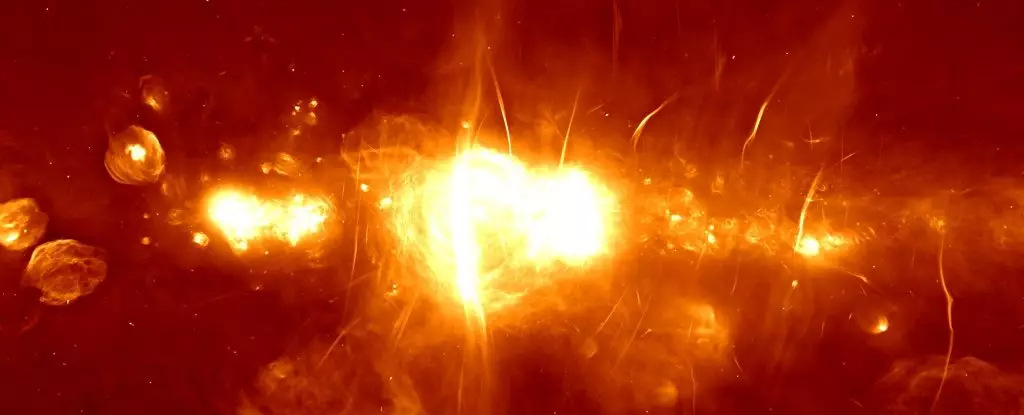The Milky Way, with its dynamic and chaotic core, continues to intrigue astronomers and astrophysicists alike. One of the most complex areas of our galaxy is the Central Molecular Zone (CMZ), a tumultuous region surrounding the supermassive black hole at the galactic center. Recent observations have revealed a captivating new phenomenon: slender gas filaments that seem to behave like cosmic tornadoes. Discovered by a team led by astronomer Kai Yang from Shanghai Jiao Tong University, these slim filaments could fundamentally change our understanding of gas dispersal in the CMZ and beyond.
Traditionally, the CMZ is recognized for its dense clouds rich in dust and molecular gas, serving as a crucible for star formation. Spanning up to 2,000 light-years, the CMZ contains a staggering 80% of the galaxy’s dense gas, contributing to its vibrant yet chaotic environment. With gas moving at remarkable speeds—up to 100 kilometers per second—the turbulence creates shock fronts that make the area a playground for cosmic phenomena. However, studying this region has always been a formidable endeavor, given the opacity and complexity of the dense clouds that inhabit it.
Unveiling the “Slim Filaments”
The research team set out to explore this challenging environment using the Atacama Large Millimeter/submillimeter Array (ALMA) in Chile, focusing on silicon monoxide—a key gas that helps trace out shock surfaces and other dynamic features. In what many would consider a fortunate surprise, they uncovered long, narrow structures meticulously mapped out in silicon monoxide at an unprecedented scale, dubbing them “slim filaments.”
What distinguishes these slim filaments from previously documented features in the CMZ is their uniqueness and the wealth of complex organic molecules they contain. These molecules—ranging from cyclopropenylidene to methanol—are not just by-products but critical components instrumental in the galactic narrative of material circulation. Yang and his colleagues have brought these filaments into the spotlight, changing the narrative from mere static structures to active participants in the ongoing molecular drama playing out in the galaxy’s heart.
The Tornado Analogy: Cosmic Chaos at Play
The comparison to tornadoes and dust devils is not merely poetic. The motion and behavior of these filaments support a model of turbulent pressure far distinct from other known entities in the galaxy. They help streamline the material cycle in the CMZ, functioning almost like an interstellar conveyor belt. As Xing Lu, another team member, asserts, these slim filaments could be crucial to our understanding of how materials are distributed and recycled within the galactic environment.
The dynamics of the CMZ are deeply interconnected, and the emergence of slim filaments may find roots in the turbulence induced by the high-speed collisions of gas clouds. These interactions could heat molecules into their gas phase, subsequently contributing to the formation of filaments. However, the precise mechanics behind their formation remain elusive, leaving scientists with an exciting puzzle to solve.
Implications for Galactic Science and Material Distribution
The discovery of slim filaments holds significant implications for our understanding of the CMZ’s complex ecological relationships. If their prevalence across the CMZ is corroborated by further studies, these structures could explain substantial portions of material recycling rates in this vibrant region. Their role is not isolated but rather integral to the ongoing transformation of the interstellar medium, revitalizing and redistributing resources necessary for new star formation.
This understanding challenges previous conceptions of the CMZ, suggesting that the galaxy’s core is far more dynamic than previously thought. The CMZ, with its swirling filaments and gaseous turbulence, is not merely a static reservoir of star-forming material but a bustling hub of activity, where interactions and processes unfold in a complex, almost chaotic ballet.
The Future of Galactic Observations
As astronomers continue to probe the intricacies of the Milky Way, the discovery of slim filaments paves the way for an enriched understanding of our cosmic neighborhood. Future missions and observational technologies could reveal even more about these fascinating structures, leading to improved models of gas dispersion and recycling throughout the galaxy. The determination of how these slim filaments fit into the broader context of galactic evolution could redefine our comprehension of cosmic mechanics.
The CMZ and its newfound slim filaments underscore the cosmos’s bewildering nature, reminding us that each new revelation opens the door to even deeper inquiries. Observational astronomy may have just skimmed the surface of understanding, hinting at myriad layers yet to be unraveled. As research progresses, scientists find themselves on an exhilarating journey that merges discovery with creative imagination—a necessity in an ever-expanding universe filled with mysteries waiting to be unveiled.

